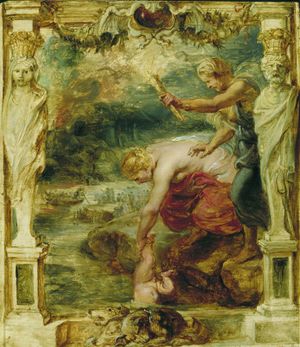阿喀琉斯之踵
阿喀琉斯之踵 Achilles' heel[1][2]是指强大整体致命的弱点。虽然“阿喀琉斯之踵”一词的神话起源指的是身体的脆弱性,但在习惯表达中也常用于其他能摧毁整体的特征或属性。
起源
在希腊神话中,当阿喀琉斯 Achilles还是个婴儿的时候,人们就预言他会英年早逝。为了阻止Achilles的死亡,他的母亲忒提丝 Thetis把他带到冥河,并把他的身体浸入河水中,因为冥河水据说可以提供刀枪不入的能力;然而,由于Thetis提着Achilles的脚后跟,所以他的脚后跟并没有被浸泡到冥河的水里。Achilles长大后成为一个战士,在许多伟大的战役中幸存下来。
尽管赫克托 Hector在荷马史诗《伊利亚特 Iliad》中预言了Achilles的死亡,但Achilles之死实际上并没有出现在《伊利亚特》中,而是出现在后来的古希腊罗马诗歌和戏剧[3]所描述的《伊利亚特》之后的事件中,后来又出现在特洛伊战争中。在围绕特洛伊战争的神话中,据说Achilles是死于脚跟[4][5] 、脚踝[6]或躯干的伤口[4] 。[7]
Classical myths attribute Achilles’s invulnerability to his mother Thetis having treated him with ambrosia and burned away his mortality in the hearth fire except on the heel, by which she held him. Peleus, his father, discovered the treatment and was alarmed to see Thetis holding the baby in the flames, which offended her and made her leave the treatment incomplete.According to a myth arising later, his mother had dipped the infant Achilles in the river Styx, holding onto him by his heel, and he became invulnerable where the waters touched him—that is, everywhere except the areas of his heel that were covered by her thumb and forefinger.
Classical myths attribute Achilles’s invulnerability to his mother Thetis having treated him with ambrosia and burned away his mortality in the hearth fire except on the heel, by which she held him. Peleus, his father, discovered the treatment and was alarmed to see Thetis holding the baby in the flames, which offended her and made her leave the treatment incomplete. According to a myth arising later, his mother had dipped the infant Achilles in the river Styx, holding onto him by his heel, and he became invulnerable where the waters touched him—that is, everywhere except the areas of his heel that were covered by her thumb and forefinger.
古典神话中将Achilles的坚不可摧归功于他的母亲Thetis曾经给他吃过珍馐(专供给神的食物),并在炉火中赋予他不死的命运,只留下了手提着的脚后跟。他的父亲珀琉斯 Peleus发现Thetis使用这种治疗方法后非常担忧,这不仅激怒了Thetis,也使她未能完成治疗。[8] 而根据后来出现的另一个神话,Achilles的母亲抓住他的脚后跟,将他在冥河水里蘸了一下,他与河水接触到的地方变得坚不可摧——除了脚后跟被他母亲的拇指和食指捏住的地方。[9]
--Agnes(讨论)[翻译]burned away his mortality中mortality一词在牛津英汉双解词典中解释为“the state of being human and not being for ever”,译者反复思考后决定译为“生命的限期”,但是原文仍然不能完全通畅,所以对于morality一词的翻译仍然存疑;
--Miyasaki(讨论) 【审校】mortality可理解为凡人必死之命运,在此处多种直译方式都不通畅,因此对burned away his mortality 做了意译处理。
--Agnes(讨论)[翻译]译者认为,原文中破折号“——”和“that is”所起到的作用相同,都是解释说明,为保证译文通常,此处采用省译,省去了that is 的翻译。
The oldest-known written record of the tendon being named for Achilles is in 1693 by the Flemish/Dutch anatomist Philip Verheyen. In his widely used text Corporis Humani Anatomia he described the tendon's location and said that it was commonly called "the cord of Achilles".[10][11] As an expression meaning "area of weakness, vulnerable spot," the use of "Achilles heel" dates only to 1840, with implied use in Samuel Taylor Coleridge's "Ireland, that vulnerable heel of the British Achilles!" from 1810 (Oxford English Dictionary).[12]
The oldest-known written record of the tendon being named for Achilles is in 1693 by the Flemish/Dutch anatomist Philip Verheyen. In his widely used text Corporis Humani Anatomia he described the tendon's location and said that it was commonly called "the cord of Achilles." As an expression meaning "area of weakness, vulnerable spot," the use of "Achilles heel" dates only to 1840, with implied use in Samuel Taylor Coleridge's "Ireland, that vulnerable heel of the British Achilles!" from 1810 (Oxford English Dictionary).
已知最古老的关于以阿喀琉斯命名跟腱的文字记录是由弗兰德/荷兰解剖学家菲利普 · 费尔海因在1693年撰写的。在他的著作《人体解剖学》中,他描述了跟腱的位置,并说它通常被称为“阿喀琉斯腱”。“阿喀琉斯之踵”这种表达,意思是“弱点所在,脆弱的地方”,最早只能追溯到1840年,同时1810年《牛津英语词典》中,塞缪尔·泰勒·柯勒律治隐晦地使用过“爱尔兰,那英国的阿喀琉斯脆弱的脚后跟!”这一表达。
解剖学 Anatomy
The large and prominent tendon of the gastrocnemius, soleus, and plantaris muscles of the calf is called the tendo achilleus or Achilles tendon. This is commonly associated with the site of Achilles's death wound. Tendons are avascular, so such an injury is unlikely to be fatal; however, the myth has the arrow poisoned with the blood of the Lernaean Hydra.
腓肠肌、比目鱼肌和跖肌的大而突出的肌腱称为小腿腱或跟腱。这个部位通常与阿喀琉斯的致命伤的部位有关。肌腱是无血管的,所以这种损伤不太可能是致命的; 然而,神话中的箭淬上了勒拿九头蛇有毒的血液。
假设箭没有沾上毒液,那么阿喀琉斯之死的解剖学基础更有可能是由位于长屈指肌腱和胫后静脉之间的内踝后侧胫后动脉的损伤导致。这个区域也可能包括在Thetis手握住的地方里。
参见
40x40px Look up Achilles heel in Wiktionary, the free dictionary.
编者推荐
本词条由Miyasaki审校本词条由Agnes初步翻译
- ↑ "Achilles heel | meaning in the Cambridge English Dictionary". dictionary.cambridge.org (in English). Retrieved 2019-09-29.
- ↑ "Achilles heel | Definition of Achilles heel by Lexico". Lexico Dictionaries | English (in English). Retrieved 2019-09-29.
- ↑ E.g. Ovid, Metamorphoses 12.580–619.
- ↑ 4.0 4.1 "Who was Achilles?". The British Museum Blog (in British English). 2019-10-15. Retrieved 2019-12-24.
- ↑ "Ancient History". HISTORY (in English). Retrieved 2019-12-24.
- ↑ http://www.perseus.tufts.edu/hopper/text?doc=Perseus%3Atext%3A1999.01.0022%3Atext%3DEpitome%3Abook%3DE%3Achapter%3D5%3Asection%3D3
- ↑ See P. J. Heslin, The Transvestite Achilles: Gender and Genre in Statius’ Achilleid, Cambridge: Cambridge University Press: 2005, 166–169.
- ↑ Apollonius, Argonautica 4.869–872
- ↑ Statius, Achilleid 1.122f., 269f., 480f.
- ↑ }}|title=Corporis humani anatomia|last1=Veheyen|first1=Philip|authorlink=Philip Verheyen|publisher=Aegidium Denique|place=Leuven|year=1693|quote=Vocatum passim chorda Achillis, & ab Hippocrate tendo magnus. (Appendix, caput XII. De musculis pedii et antipedii, p. 269) |url=https://archive.org/stream/corporishumanian00verh#page/268/mode/2up%7Caccessdate=12 Mar 2018|page=269
- ↑ Klenerman, L. (April 2007). "The early history of tendo Achillis and its rupture". The Journal of Bone and Joint Surgery. British Volume. 89-B (4): 545–547. doi:10.1302/0301-620X.89B4.18978. PMID 17463129.
- ↑ "Home : Oxford English Dictionary". www.oed.com (in English). Retrieved 2019-09-29.
